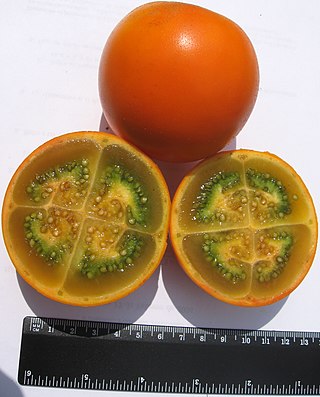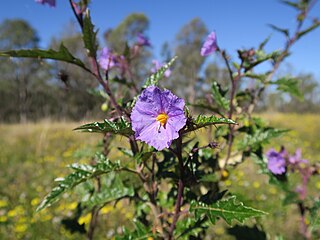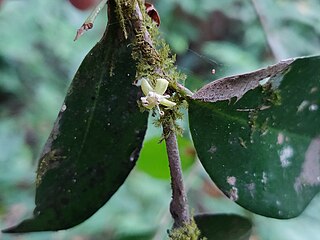
Solanum quitoense, known as naranjilla in Ecuador, Costa Rica, and Panama and as lulo in Colombia, is a tropical perennial plant from northwestern South America. The specific name for this species of nightshade means "from Quito."

Hakea laurina is shrub or small tree commonly known as kodjet or pin-cushion hakea and is endemic to Western Australia. The Noongar name for the plant is kodjet or kojet. It has red and cream conspicuous globular flowers and lance shaped leaves.

Hakea archaeoides is a large shrub or small tree commonly known as Big Nellie hakea and is endemic to forest areas on the north coast of New South Wales, Australia. It has clusters of red and greenish yellow flowers in the flowering season.
Solanum sodiroi is a species of plant in the family Solanaceae. It is possibly endemic to Ecuador.

Solanum melissarum is a small tree or shrub in the flowering plant family Solanaceae endemic to Brazil.

Brunfelsia pauciflora is a species of flowering plant in the family Solanaceae, the nightshades. It is endemic to Brazil, and it is grown in cultivation. A shrubby perennial plant grown in gardens, its common names include today, tomorrow together, yesterday, today and tomorrow, morning-noon-and-night, kiss me quick, and Brazil raintree.

Solanum physalifolium, known as hoe nightshade, Argentine nightshade, green nightshade and hairy nightshade, is a species in the family Solanaceae. Native to Argentina, Bolivia and Chile, it is widely naturalized in Australia, New Zealand, Europe, western Canada and the north western United States. Solanum physalifolium has been widely but incorrectly known as Solanum sarrachoides, a different species. It has been listed as a noxious weed in the US states of Kansas and Michigan under this misapplied name.

Solanum diphyllum, commonly known as the twoleaf nightshade, is a species of nightshade native to the Americas. It is cultivated as an ornamental plant for its clusters of dark green round fruits that turn a bright yellow when ripe.

Solanum chilense is a plant species from the "tomato" subgenus Lycopersicon within the nightshade genus Solanum.
Solanum huaylasense is a species of plant in the family Solanaceae. It is endemic to Peru.
Solanum arcanum is a species of flowering plant in the nightshade family Solanaceae in section Lycopersicon, the tomatoes, endemic to Peru.
Solanum tepuiense is a plant species native to Venezuela. It is known from one collection, from a low-elevation sandstone flat-topped mountain named Sororopán-Tepuí, near the Gran Sabana Region in the State of Bolívar in the eastern part of the country.

Solanum cinereum, commonly known as Narrawa burr, is a species of flowering plant in the family Solanaceae. It has dark green, spiny leaves and purple flowers and grows in open woodland in south eastern Australia.

Eucalyptus arachnaea, commonly known as the black-stemmed mallee, is a mallee or tree that is endemic to Western Australia. It has rough, stringy bark, lance-shaped leaves and white flowers in groups of up to thirteen.

Grevillea extorris is a species of flowering plant in the family Proteaceae and is endemic to the west of Western Australia. It is an erect shrub with linear or narrowly oblong leaves and clusters of pink to red or yellow flowers.

Solanum conocarpum, commonly known as marron bacoba, is a vascular plant species in the family Solanaceae found in the US Virgin Islands and British Virgin Islands.

Solanum pachyandrum, known as bombona, is a spine-forming vine of the Solanum genus. It is native to southwestern Ecuador and northwestern Peru where the large juicy fruit is commonly eaten and considered a treat by children. Although the plant has been known and consumed by the indigenous people of that land, it was only published scientifically in 1914 by German botanist Friedrich August Georg Bitter.
Solanum rigidum is a species of plant in the family Solanaceae. It goes by the common names olho de vaca or olho de boi.

Pomaderris delicata, commonly known as delicate pomaderris, is a species of flowering plant in the family Rhamnaceae and is endemic to a restricted area of New South Wales. It is a shrub with hairy young stems, elliptic leaves, and clusters of golden-yellow flowers.

Drypetes wightii is an evergreen tree species endemic to the Western Ghats, India. The species is considered Vulnerable under the IUCN Redlist of Threatened Species.















